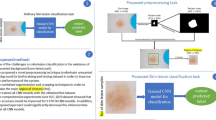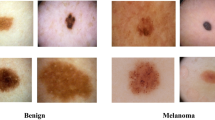Abstract
Tiny skin vessels and telangiectasia are most imperative dermoscopy configurations used to differentiate Basal Cell Carcinoma (BCC) from benign skin lesions. This research work builds off of previously developed image analysis techniques to identify vessels automatically to separate benign lesions from BCCs. In this paper, to develop a model for Intelligent Prognostics Model for Disease Prediction and Classification (IPM-DPC) from dermoscopy images is presented using the combination of Convolutional Neural Network (CNN) structure along with the Particle Swarm Optimization (PSO). Here PSO play two different roles in this proposed IPM-DPC, firstly PSO used with K-means segmentation technique to improve the segmentation accuracy then PSO is used as filter for the CNN to train the proposed IPM-DPC. Speed up Robust Features (SURF) algorithm is used as feature descriptor along with PSO as feature selection algorithm which increase the classification accuracy of the system. This study uses a dataset of 1000 dermoscopy skin lesion images of 545 BCCs and 455Non-BCCs or benign images as the input sets. This dataset is taken from ISBI-2016 Dataset and available on:www.isic-archive.com. Experimental results yielded a diagnostic accuracy as high as 99.46% using the IMP-DPC approach, providing a14.94% improvement over a system without using the PSO as filter layer in CNN. When the evaluation parameters of proposed IMP-DPC is compared with a few other state-of-art methods, the proposed method achieves the best performance in terms of accuracy and detection time in differentiating BCC and Non-BCC from dermoscopy skin lesion images.












Similar content being viewed by others
References
Ahn E, Kim J, Bi L, Kumar A, Li C, Fulham M, Feng DD (2017) Saliency-based lesion segmentation via background detection in dermoscopic images. IEEE J Biomed Health Inform 21(6):1685–1693
Benazzi C, al-Dissi A, Chau CH, Figg WD, Sarli G, Oliveira JT, Gärtner F (2014) Angiogenesis in spontaneous tumors and implications for comparative tumor biology. Sci World J 2014:1–16
Cheng B, Stanley RJ, Stoecker WV, Hinton K (2012) Automatic telangiectasia analysis in dermoscopy images using adaptive critic design. Skin Res Technol 18:389–396
Cheng B, Joe Stanley R, Stoecker WV, Stricklin SM, Hinton KA, Nguyen TK, Rader RK, Rabinovitz HS, Oliviero M, Moss RH (Feb. 2013) Analysis of clinical and dermoscopic features for basal cell carcinoma neural network classification. Skin Res Technol 19:e217–ee22
Cheng B, Stanley RJ, Stoecker WV, Hinton K, Automatic telangiectasia analysis in dermoscopy images using adaptive critic design
Choi JW, Kim BR, Lee HS, Youn SW (2014) Characteristics of subjective recognition and computer-aided image analysis of facial erythematous skin diseases: a cornerstone of automated diagnosis. Br J Dermatol 171:252–258
Codella NCF et al (2017) Deep learning ensembles for melanoma recognition in dermoscopy images. IBM J Res Dev 61(4):5–1
Farage MA, Miller KW, Maibach HI (2017). Degenerative changes in aging skin. Textbook of aging skin, 15–30.
Hames SC, Sinnya S, Tan JM, Morze C, Sahebian A, Soyer HP, Prow TW (2015) Automated detection of actinic keratoses in clinical photographs. PLoS One 10:e0112447
Kharazmi P, Lui H, Stoecker WV, Lee T (2015) Automatic detection and segmentation of vascular structures in dermoscopy images using a novel vesselness measure based on pixel redness and tubularness. Proc SPIE 9414, Computer-Aided Diagnosis:94143M
Kharazmi P, AlJasser MI, Lui H, Wang ZJ, Lee TK (2017) Automated detection and segmentation of vascular structures of skin lesions seen in Dermoscopy, with an application to basal cell carcinoma classification. IEEE J Biomed Health Inform 21(6):1675–1684
Nasr-Esfahani E, Samavi S, Karimi N, Soroushmehr SMR, Jafari MH, Ward K, Najarian K (2016) Melanoma detection by analysis of clinical images using convolutional neural network. In 2016 38th annual international conference of the IEEE engineering in medicine and biology society (EMBC) (pp. 1373-1376). IEEE.
Riaz F, Naeem S, Nawaz R, Coimbra MT (2018) Active contours based segmentation and lesion periphery analysis for characterization of skin lesions in dermoscopy images. IEEE J Biomed Health Inform 23(2):489–500
Sagar C, Saini LM (2016) Color channel based segmentation of skin lesion from clinical images for the detection of melanoma. In 2016 IEEE 1st international conference on power electronics, intelligent control and energy systems (ICPEICES) (pp. 1-5). IEEE.
Tan TY, Zhang L, Lim CP, Fielding B, Yu Y, Anderson E (2019) Evolving ensemble models for image segmentation using enhanced particle swarm optimization. IEEE Access 7:34004–34019
Taufiq MA, Hameed N, Anjum A, Hameed F (2017) M-skin doctor: a mobile enabled system for early melanoma skin cancer detection using support vector machine. In: eHealth 360°.Springer, Cham. pp 468–475
**e F, Fan H, Li Y, Jiang Z, Meng R, Bovik A (2017) Melanoma classification on dermoscopy images using a neural network ensemble model. IEEE Trans Med Imaging 36(3):849–858
Yu L, Chen H, Dou Q, Qin J, Heng P-A (2017) Automated melanoma recognition in dermoscopy images via very deep residual networks. IEEE Trans Med Imaging 36(4):994–1004
Yuan Y, Chao M, Lo Y-C (2017) Automatic skin lesion segmentation using deep fully convolutional networks with jaccard distance. IEEE Trans Med Imaging 36(9):1876–1886
Zalaudek I, Kreusch J, Giacomel J, Ferrara G, Catricala C, Argenziano G (2010) How to diagnose non pigmented skin tumors: a review of vascular structures seen with dermoscopy: part II. Nonmelanocytic skin tumors. J Am Acad Dermatol 63:377–386
Author information
Authors and Affiliations
Corresponding author
Additional information
Publisher’s note
Springer Nature remains neutral with regard to jurisdictional claims in published maps and institutional affiliations.
Rights and permissions
About this article
Cite this article
Tyagi, A., Mehra, R. An optimized CNN based intelligent prognostics model for disease prediction and classification from Dermoscopy images. Multimed Tools Appl 79, 26817–26835 (2020). https://doi.org/10.1007/s11042-020-09074-3
Received:
Revised:
Accepted:
Published:
Issue Date:
DOI: https://doi.org/10.1007/s11042-020-09074-3




